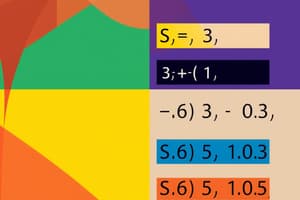Podcast
Questions and Answers
In bubble sort, what happens if the first element is greater than the second element?
In bubble sort, what happens if the first element is greater than the second element?
- The elements are left unchanged
- The elements are removed from the array
- The elements are swapped (correct)
- The algorithm stops
How many times does bubble sort need to repeat the comparison process for an array of n elements?
How many times does bubble sort need to repeat the comparison process for an array of n elements?
- $n$ times
- $n-1$ times (correct)
- $2n$ times
- $n+1$ times
What is a key characteristic of bubble sort?
What is a key characteristic of bubble sort?
- Elements are compared in pairs at a time (correct)
- Only odd-indexed elements are sorted
- Smallest element moves towards the middle of the array
- Largest element moves towards the first index
What is the main idea behind selection sort?
What is the main idea behind selection sort?
Which sorting algorithm is known for its in-place comparison-based approach?
Which sorting algorithm is known for its in-place comparison-based approach?
How does insertion sort divide the list for sorting?
How does insertion sort divide the list for sorting?
What makes merge sort different from bubble sort?
What makes merge sort different from bubble sort?
Flashcards are hidden until you start studying
Study Notes
Sorting
- Sorting is the process of arranging elements of a list in a particular order (ascending or descending) based on the key value of each record.
- There are different sorting methods, each with different running times (complexities).
Types of Sorting Methods
- Internal Sort: Does not require external memory for sorting, useful for sorting fewer elements.
- Examples: Bubble Sort, Quick Sort, Selection Sort, Insertion Sort
- External Sort: Requires external memory for sorting, useful for sorting large numbers of elements.
- Examples: Merge Sort, Radix Sort
Bubble Sort
- A simple sorting algorithm that compares all elements one by one and sorts them based on their values.
- Not suitable for large data sets due to average and worst-case complexities of O(n2), where n is the number of items.
Quick Sort
- An efficient sorting method for large lists, using a divide and conquer strategy.
- Divides the list into two smaller lists, then recursively sorts the sublists.
- Pivot element is used to divide the list, and elements are swapped accordingly.
Selection Sort
- A simple sorting algorithm that is an in-place comparison-based algorithm.
- Divides the list into two parts: the sorted part (at the left end) and the unsorted part (at the right end).
- Selects the smallest element from the unsorted array and swaps it with the leftmost element, repeating the process until the entire list is sorted.
Studying That Suits You
Use AI to generate personalized quizzes and flashcards to suit your learning preferences.




